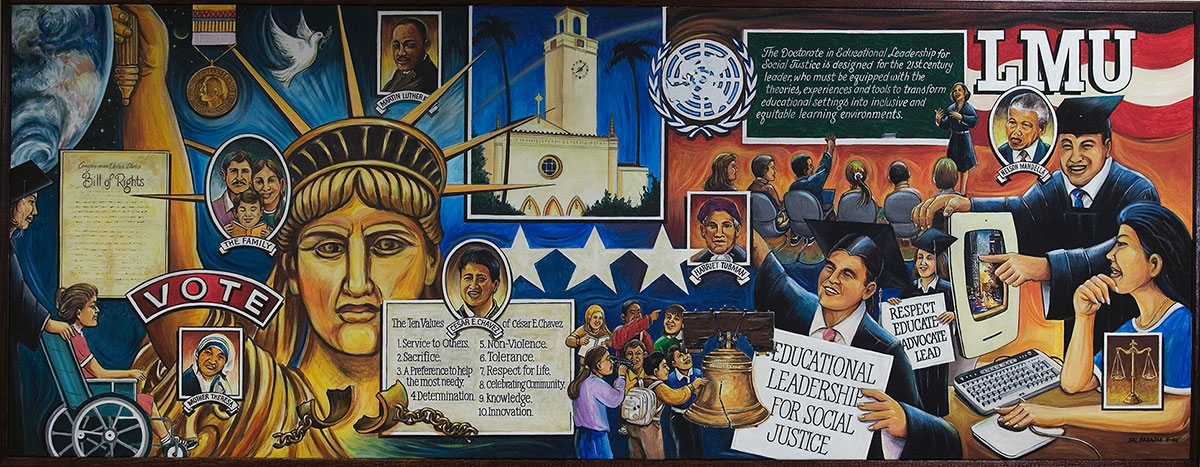
“When you are a minority, you go through a lot of stuff,” says painter Salvador Barajas, “and when you go through discrimination in the labor force, when you see police brutality, when you see the border patrol abusing people; when you become aware, you want to say something about it.”
For nearly 50 years, the Mexican-born artist has been influenced as much by his own immigrant story as an attempt to balance community and social justice, making him the perfect candidate to have designed the mural for the office of LMU’s doctoral program in Educational Leadership for Social Justice in the School of Education.
Constructed as a portable 7 ½ x 3-foot display, the mural was erected as the Ed.D. program was launched and just before the first cohorts arrived in June 2004. The artwork serves as an artistic, visual and historical representation of the people and ideas at the cornerstone of social justice.
Barajas’ influences, seen in the work, are unmistakable — from a pictorial of the Bill of Rights to portraits of Nelson Mandela, the Rev. Dr. Martin Luther King, Jr., and Mother Theresa. Also shown are the “Ten Values” of César E. Chavez, the grand image of the Statue of Liberty, and even shattered chains of slavery, which bespeak a global social justice movement and education in action.
“I wanted to make it a story,” Barajas says. “I think all universities should have a mural like this one that really tells the story of our cultures and our heritage. Many times, schools don’t want to get involved in issues that are, to them, controversial, but these are stories that need to be told.”
Commissioned by Magaly Lavandez, professor in the Department of Educational Leadership and director for the Center for Equity for English Learners, as “something to decorate the office,” the mural was allotted a $2,000 budget. (Barajas considered it a gift to the university where, Xóchitl ’05, the youngest of his four children, was enrolled at the time.) But Lavandez received something much more valuable than she foresaw.
“Overall, the representativeness of people [involved with] local, national and international justice and peace [efforts] is what I really love about this mural,” says Lavadenz, who has been acquainted with Barajas’ company, Motivational Designs, since her days as an elementary school teacher. “That he would give so generously of himself and his time was just miraculous.”
At 18, Barajas moved to San Diego with his family from Tijuana. While serving in the U.S. Air Force, Barajas worked as a technical illustrator and moved into advertising and design at Los Angeles Trade Technical College. He later studied at both the Academy of Arts in San Francisco and San Diego State University. Barajas was active in the Chicano studies movement, and by 1973 became one of the original muralists of San Diego Chicano Park murals, playing a key role in the Chicano Park Mural Restoration Project.
“If you’re going to label me as something, label me as a part-time activist and a full-time professional student of the arts, because I’m still learning,” Barajas says, “learning how to project my feelings, my frustrations and so forth. It’s a controlled anger.”
His legacy at LMU is nonetheless an ever-present symbol of hope, says doctoral student David Chavez.
“When I look at the mural, I think of all the struggles that have come before us and how education has helped us and continues to be the catalyst to create social justice,” Chavez says. “It speaks volumes to the whole of social justice, and inspires one to continue moving forward.”
